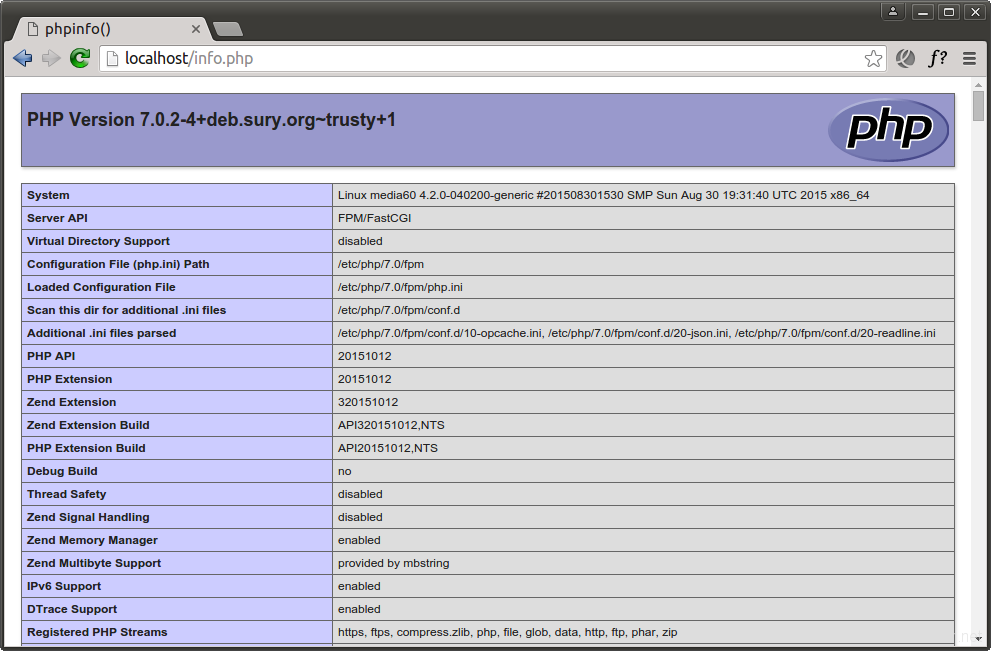unbuntu安装PHP7&PHP-FPM nginx mysql
- 来源:开源中国
- 更新日期:2018-03-23
摘要:安装之后的php管理位置在 $: cd /etc/init.d/ $: sudo php-fpm7.0 {start|stop|status|restart|reload|force-reload} 安装之后的nginx管理位置在 $: cd /etc/init.d/ $: sudo ./nginx {start|stop|restart|reload|force-r
$:cd/etc/init.d/ $:sudophp-fpm7.0{start|stop|status|restart|reload|force-reload}
安装之后的nginx管理位置在
$:cd/etc/init.d/ $:sudo./nginx{start|stop|restart|reload|force-reload|status|configtest|rotate|upgrade}
nginx配置文件:
$:sudovi/etc/nginx/sites-available/default#虚拟主机默认配置文件 $:sudovi/etc/nginx/nginx.conf#默认配置文件

执行文件:
/usr/sbin/php-fpm7.0 /usr/sbin/nginx Step 1 – Install PHP 7 & PHP-FPM
First install python-software-properties package on your system which provides add-apt-repository command then use the following set of commands to add PPA for PHP 7 in your Ubuntu system and install it.
$sudoapt-getinstallpython-software-properties $sudoadd-apt-repositoryppa:ondrej/php $sudoapt-getupdate $sudoapt-getinstall-yphp7.0php7.0-fpm
Step 2 — Install Nginx
First we will install Latest Nginx web server on our system. Use the following commands to add PPA for installing latest Nginx version on your Ubuntu 14.04 (Trusty).
$echo"debhttp://nginx.org/packages/mainline/ubuntu/`lsb_release-cs`nginx">>/etc/apt/sources.list $echo"deb-srchttp://nginx.org/packages/mainline/ubuntu/`lsb_release-cs`nginx">>/etc/apt/sources.list
and use the following commands to install Nginx web server.
$curlhttp://nginx.org/keys/nginx_signing.key|apt-keyadd- $sudoapt-getupdate $sudoapt-getinstallnginx
Step 3 — Install MySQL 5.6
Use the following commands to install or upgrade MySQL 5.6 on your Ubuntu systems. At the last update of this tutorial MySQL 5.6.27 is latest available MySQL version in series of MySQL 5.6.X.
$sudoadd-apt-repository-yppa:ondrej/mysql-5.6 $sudoapt-getupdate $sudoapt-getinstallmysql-server-5.6
Step 4 — Install Other Requirements
You may also need to install modules like PHP7-MySQL, etc based on your application requirements. Use the following command to find our available php 7 modules.
$sudoapt-cachesearchphp7-*
Above command will list all available PHP7 modules for installation, Let’s begin installation of modules.
$sudoapt-getinstallphp7.0-mysqlphp7.0-curlphp7.0-json
Step 5 — Configure PHP-FPM
PHP-FPM (FastCGI Process Manager) is an alternative PHP FastCGI implementation with some additional features.
$sudonano/etc/php/7.0/fpm/php.ini
un-comment cgi.fix_pathinfo=1 line and set value to 0.
cgi.fix_pathinfo=0
Now set the listen parameter in /etc/php/7.0/fpm/pool.d/www.conf configuration file. Here you can use php7.0-fpm socket to work or start php7.0-fpm service on specific port. We are going to use it as service .
$sudonano/etc/php/7.0/fpm/pool.d/www.conf
Now make changes in configuration file as below. Commend listen with socket file and enable it as service
#listen=/run/php/php7.0-fpm.sock listen=127.0.0.1:9000
Step 6 — Configure Nginx VirtualHost
Finally do the configuration of Nginx virtualhost. For this example we are editing default configuration file.
$sudonano/etc/nginx/conf.d/default.conf
and make changes as below.
server{ listen80; root/var/www; indexindex.phpindex.htmlindex.htm; server_nameexample.comwww.example.com; location/{ try_files$uri$uri//index.html; } error_page404/404.html; error_page500502503504/50x.html; location=/50x.html{ root/usr/share/nginx/www; } location~.php${ try_files$uri=404; fastcgi_pass127.0.0.1:9000; fastcgi_indexindex.php; fastcgi_paramSCRIPT_FILENAME$document_root$fastcgi_script_name; includefastcgi_params; } }
You have to do the same changes in all VirtualHosts configured.
Step 7 – Restart ServicesAfter installing all services on your system, start all required services.
$sudoservicenginxrestart $sudoservicephp7.0-fpmrestart
Step 8 – Open Access in Firewall
If you are using iptables, Use following commands to open port 80 for public access of webserver.
Iptables Users:$sudoiptables-AINPUT-mstate--stateNEW-ptcp--dport80-jACCEPT
UFW Users:
$sudoufwallow80/tcp
Step 9 – Verify Setup
Finally verify installation of PHP 7 with NGINX. Let’s create a file info.php on website document root using following content.
[php]
<?php
phpinfo();
?>
[/php]
Now browse this file in web browser. It will so all the details about version’s and installation.

相关文章推荐
虚拟主机的专业参数,分别都是什么意思?2022-09-09
中非域名注册规则是怎样的?注册域名有什么用处? 2022-01-10
HostEase新年活动促销 美国/香港主机全场低至五折2021-12-28
HostGator下载完整备份教程分享2021-12-28
Flink中有界数据与无界数据的示例分析2021-12-28
